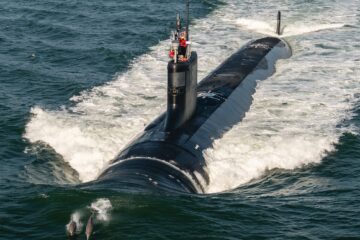The new 3,000-tonne diesel-electric submarine (SSK), which has been named 「らいげい」 Raigei (with pennant number SS 516), entered the water on October 17 in a ceremony held at KHI’s facilities in Kobe City. The newly launched SSK will use the new Kawasaki 12V 25/31 diesel engines with high output power for the first time.
Raigei, which cost about 70.2 billion yen ($470 million) to build, is expected to enter service in March 2025. Raigei means “thunder whale” in Japanese. The Taigei-class submarines all incorporate “Gei” (whale) into their names, following the “Shio” (tide) and “Ryu” (dragon) series seen in previous JMSDF submarines. “Taigei” itself means “big whale.”
According to the JMSDF, the new submarine has a crew complement of about 70, an overall length of 84 meters, a beam of 9.1 m, a draught of 10.4 m, and a standard displacement of about 3,000 tonnes. It is just slightly larger than the preceding Soryu-class SSKs, which have a standard displacement of 2,950 tonnes.
The Taigei-class features female-only compartments such as a living space for up to six women, according to the JMSDF. This is a first for a Japanese class of submarines.
New diesel engines

Until the third Taigei-class submarine Jingei, two Kawasaki 12V 25/25SB diesel engines were used as the main engines, but Raigei will use new Kawasaki 12V 25/31 diesel engines with a high output power for the first time. These new diesel engines are compatible with a new snorkel system with enhanced power generation efficiency. It is still not clear whether this will increase the shaft output of the Taigei-class, currently generating 6,000 horsepower, as well as a maximum speed underwater of 20 knots.
Lithium-ion batteries
The JMSDF said that the Taigei-class is equipped with lithium-ion batteries in place of lead-acid ones, just like the final two Soryu-class boats for the JMSDF: Oryu (SS 511) and Toryu (SS 512).
GS Yuasa, a Kyoto-based developer and manufacturer of battery systems, provided the lithium-ion batteries for those new submarines. So far Japan is the only country known to have fitted lithium-ion batteries into SSKs, with South Korea expected to be the next country to do so with the second batch of KSS-III (also known as Dosan Ahn Chang-ho)-class submarines.
New CMS and snorkel
The class also employs a new combat management system (CMS) combining advanced integrated sensors, command-and-control, and weapon engagement systems, the Japanese MoD said.
In addition, it adopts an enhanced snorkel system to reduce signatures, and a new-generation sonar system based on fiber-optic array technology to enhance detection capability.
Taigei-class SSK weapons
The Taigei-class employs the same torpedo counter-measures system that has been incorporated into the last four Soryu-class boats. It is expected to use Japan’s newest torpedo, which is called the Type 18, succeeding the previous Type 89. The new torpedo will feature improvements in a number of areas, including propulsion, target detection, and processing.
The class is also capable of deploying the UGM-84L Harpoon Block II anti-ship missile against surface targets. This missile range is 248 km – enough to provide Japan with a “counterattack” capability.
Taigei-class submarine program so far
The lead submarine of the Taigei-class, named Taigei (SS 513), was commissioned in March 2022. The second of the class, named Hakugei (SS 514), entered service in March 2023. Launched in April 2020, the third of the class, named Jingei (SS515), is expected to enter service in March 2024.
Pictures by Twitter user @TAIGEI_SS513, used with permission.






